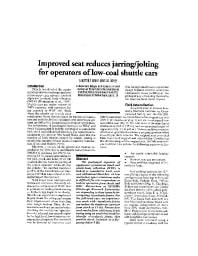Mining Publication: Improved Seat Reduces Jarring/Jolting for Operators of Low-Coal Shuttle Cars
Original creation date: December 1999
Authors: AG Mayton, R Merkel, S Gallagher
Nearly one-third of the equipment operators in underground coal mines experience adverse levels of exposure to whole-body vibration (WBV). Shuttle cars are major sources of WBV exposure, with operators being exposed to WBV and shock when the shuttle car travels over rough mine floors characterized by numerous bumps, ruts and potholes. In low coal mines, seat suspension systems are difficult to design because of space restrictions. The seriousness of prolonged exposure to WBV and shock is demonstrated by their connection to cumulative back, neck and abdominal disorders. For underground-equipment operators in New South Wales, Australia, the number of back injuries caused by vehicle jarring is equal to the number of back injuries caused by overexertion. Moreover, a review of the shuttle-car injuries recorded in the Mine Safety and Health Administration's (MSHA's) database for 1997 is revealing. Of the injuries pertaining to the back, neck and head, 57 of 100 resulted directly from the jarring of the seated operator while driving the vehicle. This number translates to 25% of the total shuttle-car injuries in 1997 that were related to jolting/jarring of the operator. With input from underground shuttle-car operators, this study addressed a component of WBV that is germane to underground mining: high-energy impacts or shocks. Shuttle-car operators complained largely about the jolting and jarring they experienced when traveling over rough bottom. Thus, the research focused on a means for better isolating the shuttle-car operator from the jolts and jars caused largely by the high-level, low-frequency, terrain-induced impacts. The approach was to develop an improved seat that incorporated more ergonomic design features and that would use viscoelastic foam padding as the principal way of isolating the shuttle-car operator from shock impacts.

- Back Injury Control Measures for Manual Lifting and Seat Design
- Biomechanical Modeling of Spinal Loading Due to Jarring and Jolting for Heavy Equipment Operators
- Comfort Evaluation for Mine Shuttle Car Seat Designs
- Comparison of Passive Seat Suspension with Different Configuration of Seat Pads and Active Seat Suspension
- Ergonomic Seat With Viscoelastic Foam Reduces Shock on Underground Mobile Equipment
- Job Design: An Effective Strategy for Reducing Back Injuries
- Nature and Cost of Low Back Pain
- Shock Reduction for Low-Coal Shuttle Car Operators Using Viscoelastic Seating Foam
- Systematic Comparison of Different Seats on Shuttle Cars Used in Underground Coal Mines
- Whole-Body Vibration Exposure Comparison of Seat Designs for Low- and Mid-Seam Shuttle Cars in Underground Coal Mines